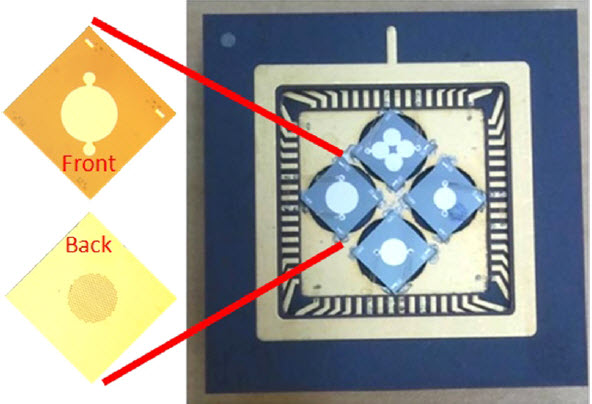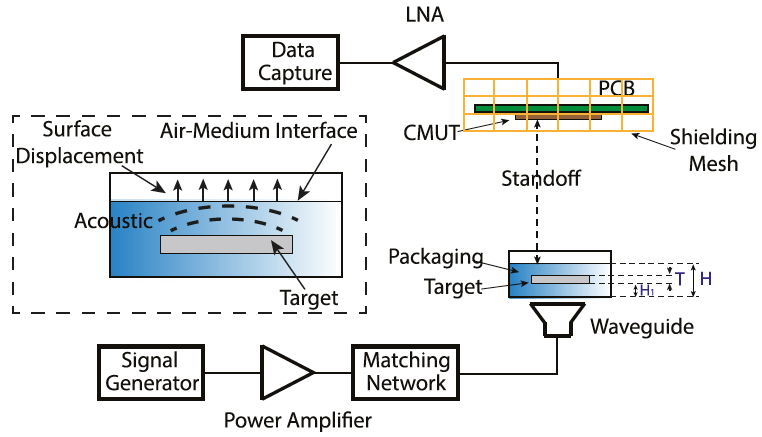New ‘tricorder’ technology might be able to ‘hear’ tumors
November 9, 2015

Capacitive micromachined ultrasonic detectors used in the experiments, with a detail view of the front and back of one device (credit: Hao Nan et al./Applied Physics Letters)
Stanford electrical engineers have developed an enhancement of technology intended to safely find buried plastic explosives and spot fast-growing tumors, using a combination of microwaves and ultrasound to develop a detector similar to the legendary Star Trek tricorder.
The work, led by Assistant Professor Amin Arbabian and Research Professor Pierre Khuri-Yakub, grows out of DARPA research designed to detect buried plastic explosives, but the researchers said the technology could also provide a new way to detect early stage cancers.
The new work was spurred by a challenge posed by the Defense Advanced Research Projects Agency (DARPA), which sought a system to detect plastic explosives (improvised explosive devices or IEDs) buried underground, which are currently invisible to metal detectors. The detection device could not touch the surface in question, so as not to trigger an explosion.
The engineers developed a system based on the principle that all materials expand and contract when heated, but not at identical rates. In a potential battlefield application, the microwaves would heat the suspect area, causing the muddy ground to absorb energy and expand, and thus squeeze the plastic. Pulsing the microwaves would then generate a series of ultrasound pressure waves that could be detected and interpreted to disclose the presence of buried plastic explosives.
Touchless ultrasound detection
Sound waves propagate differently in solids than air, with a drastic transmission loss occurring when sound jumps from the solid to air. So the Stanford team accommodated for this loss by building highly sensitive capacitive micromachined ultrasonic transducers (CMUTs) that can specifically discern the weaker ultrasound signals that jumped from the solid, through the air, to the detector.
Solving the technical challenges of detecting ultrasound after it left the ground gave the Stanford researchers the experience to take aim at their ultimate goal: Using the device in medical applications without touching the skin.

Schematic of the non-contact thermoacoustic detection setup. H is the thickness of the surrounding packaging material (set to between 1 and 3 cm of water or Agarose), corresponding to the surrounding flesh-like tissue. T is the thickness of the embedded target (Rexolite, in this case, set to 4mm layers and target area of 4 square cm), corresponding to a tumor. In microwave-induced thermoacoustic imaging, the target absorbs a portion of the microwave electromagnetic energy (from the microwave signal generator) based on the the target tissue’s dielectric properties, producing an ultrasonic wave that is then detected by the airborne capacitive micromachined ultrasonic transducers (CMUT). The corresponding data is then captured for use in reconstructing the target image. (credit: Hao Nan et al./Applied Physics Letters)
Arbabian’s team used brief microwave pulses to heat a flesh-like material that had been implanted with a sample “target.” Holding the device at a standoff distance of 30 cm, the material was heated by a mere thousandth of a degree, well within safety limits. Yet even that slight heating caused the material to expand and contract, which, in turn, created ultrasound waves that the Stanford team was able to detect to disclose the location of the 4 square centimeter embedded target, all without touching the “flesh” — just like the Star Trek tricorder.
Prior medical research showed that tumors grow additional blood vessels to nourish their cancerous growth. Like wet ground, blood vessels absorb heat differently than surrounding tissue, so tumors should show up as ultrasound hotspots.
“We think we could develop instrumentation sufficiently sensitive to disclose the presence of tumors, and perhaps other health anomalies, much earlier than current detection systems, non-intrusively and with a handheld portable device,” Arbabian said.
The researchers believe that their microwave and ultrasound detection system will be practical and widely available within 10 to 15 years. It would be more portable and less expensive than other medical imaging devices such as MRI or CT, and safer than X-rays.
The experiments are detailed in Applied Physics Letters and were presented at the International Ultrasonics Symposium in Taipei, Taiwan.
Stanford University | Stanford Engineers Test Tricorder-Like Detector
Abstract of Non-contact thermoacoustic detection of embedded targets using airborne-capacitive micromachined ultrasonic transducers
A radio frequency (RF)/ultrasound hybrid imaging system using airborne capacitive micromachined ultrasonic transducers (CMUTs) is proposed for the remote detection of embedded objects in highly dispersive media (e.g., water, soil, and tissue). RF excitation provides permittivity contrast, and ultra-sensitive airborne-ultrasound detection measures thermoacoustic-generated acoustic waves that initiate at the boundaries of the embedded target, go through the medium-air interface, and finally reach the transducer. Vented wideband CMUTs interface to 0.18 μm CMOS low-noise amplifiers to provide displacement detectionsensitivity of 1.3 pm at the transducer surface. The carefully designed vented CMUT structure provides a fractional bandwidth of 3.5% utilizing the squeeze-film damping of the air in the cavity.